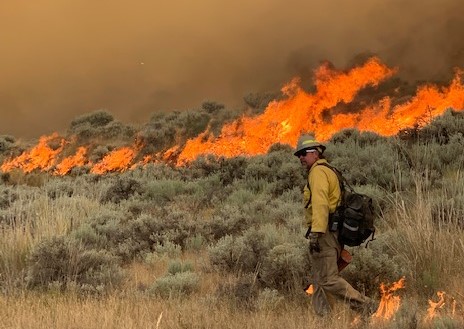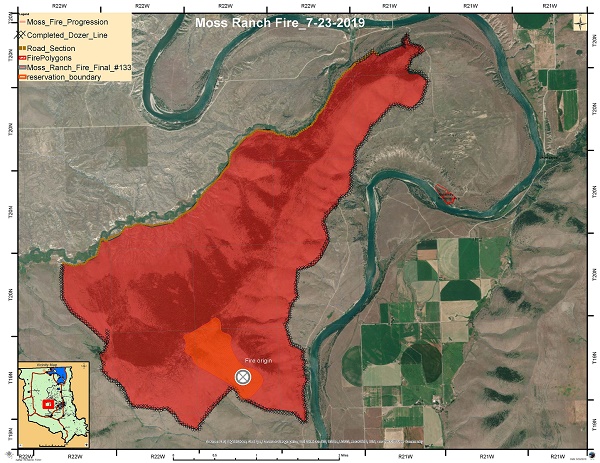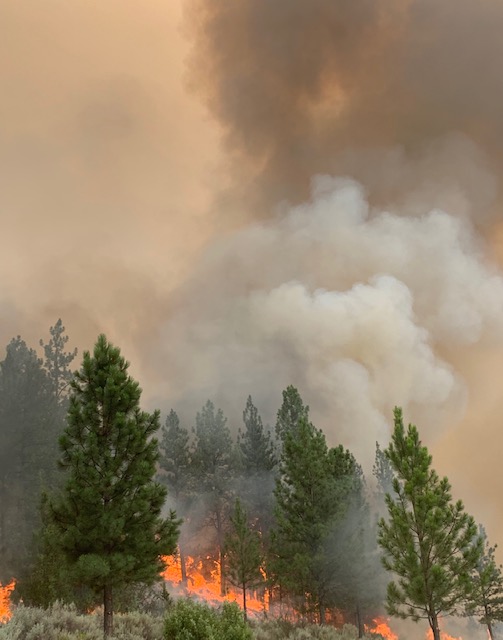You are viewing ARCHIVED content published online before January 20, 2025. Please note that this content is NOT UPDATED, and links may not work. Additionally, any previously issued diversity, equity, inclusion or gender-related guidance on this webpage should be considered rescinded.
Author: Robyn Broyles
On July 23, 2019, lightning sparked the Moss Ranch Fire on the Confederated Salish and Kootenai Tribes (CSKT) trust lands. Striking midway up a remote slope in a steep, rocky, portion of the Flathead River corridor, the wildfire grew faster in the cured grass and sagebrush than wildland firefighters could suppress it. Adding to this were safety complications firefighters experienced—bees were swarming, stinging the faces and necks of multiple firefighters which required emergency medical care for two of the firefighters that had allergic reactions.
Adapting to rapidly evolving circumstances, the Tribe assembled an Incident Management Team (IMT) comprised of Tribal staff to manage the wildfire.
Safety First – It always Rules
Fire management staff worked with IMT members to determine the safest, most effective way to contain the wildfire. After a thorough review, they recommend using existing roads and trails and constructing some additional miles of hand line to ignite fire from- using fire to contain the wildfire.
Burning vegetation ahead of the wildfire’s front stops the wildfire when it hits the new blackened area. This tactic, called a burnout, is a common, and effective means of containing wildfires.
If ignited, the total fire size would be about nine square miles (5,700 acres).

Firefighter drags fire behind him in a planned pattern igniting grass and brush ahead of the wildfire's front. Photo: CSKT
Determining Pros and Cons
This strategy was not only the most efficient for firefighters, it also gave them a safer position from which to extinguish it. This approach also required fewer resources.
Using existing roads also meant firefighters didn’t have to cause unnecessary damage to the remote landscape, which ranchers valued as prime grazing habitat; and because fewer resources were needed to do the work, the cost to suppress the $1.1 million wildfire was also kept lower.
The downside to this plan was that it required putting more fire on the ground than what was already naturally burning. It also required coordination with multiple Tribal natural resource programs and the Montana Department of Natural Resources Conservation as a small piece of their land would be impacted.

Final Moss Ranch fire perimeter; 8.2 square miles (5,300 acres). Darker red area shows original fire perimeter and area of spread to the northwest. Photo by CSKT
Briefing the Plan & Working with Cooperators
While the wildland fire management staff understood the risks and how to reduce them, they still needed concurrence from the Tribal Council whose concern included the interests of the Montana Cattleman’s Association, an important Tribal partner.
After consulting with the Association to understand their concerns, fire managers adjusted the location of the eastern containment line to protect prime grazing land while still using the natural terrain to their advantage, making the area safer for firefighters to work.
Implementing the Plan
On July 25, firefighters began improving and constructing 17 miles of containment line that would serve as the fire’s perimeter. One day later, firefighters began burning the grass, brush and conifers that were encroaching into the meadows.
Assisting with the operation was the Mission Valley Helitack Crew which supported a helicopter that dropped plastic sphere dispensers to ignite the more remote interior areas. A hand crew ignited the fire in a planned pattern to keep the fire’s heat concentrated in the desired direction while other firefighters staffed fire engines and skidgens to deliver water to the edges to ensure the fire did not escape beyond the established containment area.
Working against an oncoming dry cold front that held the potential to bring erratic, high winds, firefighters were successful at keeping the fire within its desired footprint. At the end of their long and successful day, the wildfire was contained at 8.2 square miles (5,300 acres).
Environmental Outcomes
The remote vegetation of the Mission Valley Mountains evolved with fire; however, for decades, the area has suffered from fire exclusion. Now, thanks to the careful work of fire managers and professional firefighters, the Moss Ranch wildfire successfully reintroduced fire to the landscape. Consequently, juniper trees and other invasive plants that are encroaching into natural meadows are now gone. New nutrients will be recycled into the soil, which will provide richer forage for cattle and wildlife in the years ahead.
Stronger Partnerships
In times of crisis, wildfires can bring people and partners together to achieve a common goal. This was true of the Moss Ranch Fire. Through open communication, fire managers came to understand the concerns of the Cattlemen’s Association and adjusted their fire suppression tactics to reduce the overall impacts. At the same time, Association members came to accept the benefits of using carefully managed fire to protect and improve the quality of grassland areas.
Using Wildfire to Accomplish Vegetation Treatments
Prior to the Moss Ranch wildfire, Tribal land managers had approved a land management plan calling for a prescribed fire to reduce conifer encroachment and enhance wildlife
wintering habitat. An approved Environmental Assessment (EA), a necessary component required by the National Environmental Policy Act (NEPA), was ready as was other requirements; however, due to lightning, the wildfire replaced the need to perform the scheduled prescribed fire.
Future Management
When considering ways to manage wildfires, firefighter safety is always the first priority for fire managers. In the case of the Moss Ranch wildfire, multiple management objectives were also met by taking a bigger approach. Firefighters were kept safer, additional long-term disturbance to the land was minimized, partnerships were strengthened and our landscapes were made healthier for future use.
For Immediate Release: September 1, 2019


